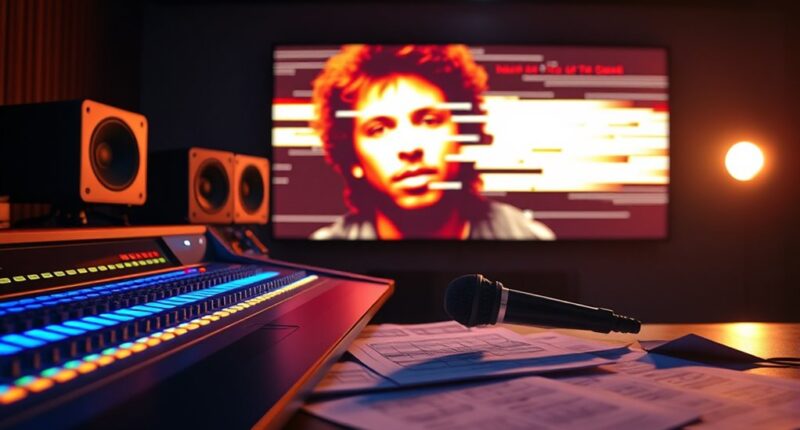The U.S. “Take It Down” Act aims to protect musicians’ rights by targeting harmful deepfake content and holding online platforms accountable. It encourages tech companies to develop AI detection tools, speeds up the removal of fake videos and audio, and requires platforms to disclose when content is AI-generated. By tightening enforcement and promoting transparency, the act seeks to create a safer space for creators. If you want to learn how this legislation impacts digital content, keep exploring these details.
Key Takeaways
- The Act aims to protect musicians’ rights by enabling swift removal of deepfake and AI-generated content infringing on their likenesses.
- It mandates platforms to develop detection tools to identify and differentiate authentic content from manipulated deepfakes.
- The legislation holds online platforms accountable for hosting unauthorized or infringing AI-generated material.
- It requires platforms to disclose when content is AI-generated and obtain permissions for using musicians’ likenesses.
- The Act promotes ethical AI use and creates a safer digital environment that respects creators’ intellectual property rights.

Have you heard about the U.S. “Take It Down” Act? This legislation aims to address the growing concerns surrounding deepfakes, AI-generated content, and how they impact musicians’ rights. As AI technology advances rapidly, it becomes increasingly important to implement AI regulation that protects creators from unauthorized use of their work. The act seeks to establish clearer standards for online platforms to identify and remove malicious deepfake videos and audio that falsely depict musicians or use their likeness without permission. This effort not only targets harmful misinformation but also bolsters copyright enforcement, ensuring that artists retain control over their intellectual property.
You might wonder how AI regulation plays a role here. Well, the legislation sets guidelines for technology companies to develop better tools for detecting AI-generated content that infringes on copyrights. These tools help identify unauthorized reproductions or manipulations of original works, making platforms responsible for quicker takedowns. With more effective AI regulation, platforms are encouraged to implement systems that can differentiate between legitimate content and deepfakes or unauthorized copies, reducing the spread of misleading or damaging material. This is essential because, without proper regulation, malicious actors can exploit AI to create convincing fake content, harming musicians’ reputations and financial interests. Additionally, the use of advanced detection algorithms can significantly improve the ability to distinguish authentic from manipulated content.
The act also emphasizes the importance of copyright enforcement. Musicians and creators often find their work being used without permission, especially in the digital realm where content can be copied and manipulated easily. By strengthening copyright enforcement measures, the legislation aims to hold accountable those who produce or distribute fake or infringing content. This means that when a deepfake video or AI-generated audio falsely portrays a musician, the platform hosting the content must act swiftly to remove it, and rights holders can pursue legal action when necessary. Such measures help protect creators’ rights, ensuring they are compensated fairly and their work isn’t exploited.
Strengthening copyright enforcement ensures swift removal of fake content and fair compensation for creators.
Additionally, the act promotes transparency in how platforms handle AI content. Platforms will need to clearly disclose when content is AI-generated and obtain appropriate permissions when using a musician’s likeness. This transparency supports both copyright enforcement and ethical standards, giving artists more control over their images and voices. Overall, the “Take It Down” Act aims to create a safer digital environment where AI technology is used responsibly, and artists’ rights are safeguarded amid the rise of deepfakes and AI-generated content. You can see it as a essential step toward balancing innovation with the protection of creators, ensuring that AI benefits everyone without undermining the rights of musicians or other artists.
Frequently Asked Questions
How Does the Act Define “Deepfake” Technology?
The act defines “deepfake” technology as a form of synthetic media that uses digital impersonation to create or alter images, videos, or audio in a way that can deceive viewers. It involves manipulating content to make it appear genuine, often without consent. This technology can be used maliciously, so the act aims to regulate its use, especially when it impacts artists’ rights or spreads misinformation.
What Protections Do Musicians Currently Lack Against Deepfake Misuse?
You currently lack strong protections against deepfake misuse that threaten your digital rights and privacy. Deepfakes can imitate your voice or image, risking unauthorized use and potential harm to your reputation. Without clear legal safeguards, it’s easier for malicious actors to exploit your likeness, raising privacy concerns. You need updated laws that defend your rights, prevent misuse, and guarantee control over your digital identity in this evolving technological landscape.
Will the Act Affect Existing Legal Rights for Content Creators?
The act is like a safety net, catching current legal rights for content creators and shaping future ones. It could strengthen protections, aligning with existing intellectual property laws and legal precedents, but may also introduce new rules. You might see clearer boundaries for deepfake misuse, yet some rights could shift or face ambiguity. Overall, it aims to enhance musicians’ rights, but you’ll want to stay attuned to how it influences existing legal frameworks.
How Quickly Can Takedown Requests Be Processed Under the Act?
Under the act, takedown requests are processed relatively quickly, often within days, thanks to streamlined procedures for digital rights enforcement. You’ll find that content moderation becomes more efficient, with platforms required to act swiftly to remove deepfake content that infringes on rights. This rapid response helps protect your digital rights, ensuring that harmful or infringing deepfakes are taken down promptly, maintaining a safer online environment for content creators like you.
Are There Exemptions for Parody or Educational Use?
Imagine a painter’s canvas where parody exemptions and educational use act like transparent overlays, allowing certain images to shine through without modification. Under the act, these exemptions protect some deepfake content used for satire or learning, meaning you can create or share these without fear of takedown. However, the protections are specific, so always check if your parody or educational content qualifies before sharing widely.
Conclusion
As you consider the U.S. “Take It Down” Act, remember that over 96% of online content is generated by users like you. This law aims to protect musicians’ rights from deepfake misuse, ensuring your favorite artists aren’t exploited. Staying informed helps you understand how legislation shapes digital creativity and safeguards creators. So, next time you encounter a deepfake, think about how policies like this work to keep your digital world fair and authentic.









